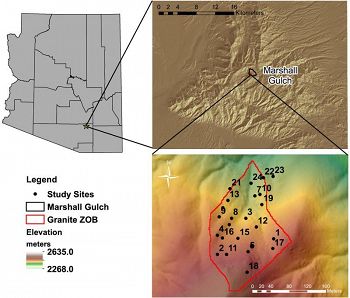Shepard et at., 2018
Understanding Critical Zone Evolution through Predicting the Three-Dimensional Soil Chemical Properties of a Small Forested Catchment
Shepard C., Schaap M.G., Chorover J., Rasmussen C. (2018)
Soil Science Society of America Journal 82(6): 1538-1550
-
Catalina-Jemez, GRAD STUDENT
-
Catalina-Jemez, INVESTIGATOR
-
Catalina-Jemez, INVESTIGATOR
Abstract
Location of the study catchment in the Santa Catalina Mountains in Arizona, USA. Location of the Marshall Gulch catchment, the study catchment, and the 24 soil pits used in the manuscript.
Understanding critical zone evolution and function requires an accurate assessment of the distributions of its soil physical and chemical properties. Two-dimensional (2D) digital soil mapping (DSM) provides a general understanding of soil characteristics across landscapes, but lacks the ability to predict soil properties with depth. Soil depth functions enable the reconstruction of soil properties with depth, potentially extending traditional DSM techniques to three dimensions (3D). We predicted the three-dimensional soil chemical and physical properties of a small forested subcatchment of the Catalina-Jemez Critical Zone Observatory using a combination of profile depth functions and traditional DSM techniques. The step function was used to reconstruct selected soil chemical and physical properties with depth for 24 described soil profiles. We compensated for uneven sampling depths by standardizing the profiles from 0.0 to 1.0, and splitting them into five equal standardized depth layers. Using available environmental covariates, step-wise regressions were used to predict soil properties across the catchment. R2 values for the predictive functions ranged from 0.20 to 0.97 (p = 0.21 to <0.0001). Calcium and magnesium preferentially accumulated in channel drainages compared to potassium or sodium; this pattern corresponded with accumulation of clay in channel drainages. Parent material and sediment redistribution, driven by colluvial movement and hydrological flowpaths, were the main controls on the 3D soil chemical properties of the catchment. Combining depth functions with traditional DSM will provide more accurate assessments of soil spatial patterns across landscapes and with depth.
Citation
Shepard C., Schaap M.G., Chorover J., Rasmussen C. (2018): Understanding Critical Zone Evolution through Predicting the Three-Dimensional Soil Chemical Properties of a Small Forested Catchment. Soil Science Society of America Journal 82(6): 1538-1550. DOI: 10.2136/sssaj2018.03.0119
 This Paper/Book acknowledges NSF CZO grant support.
This Paper/Book acknowledges NSF CZO grant support.
Explore Further




